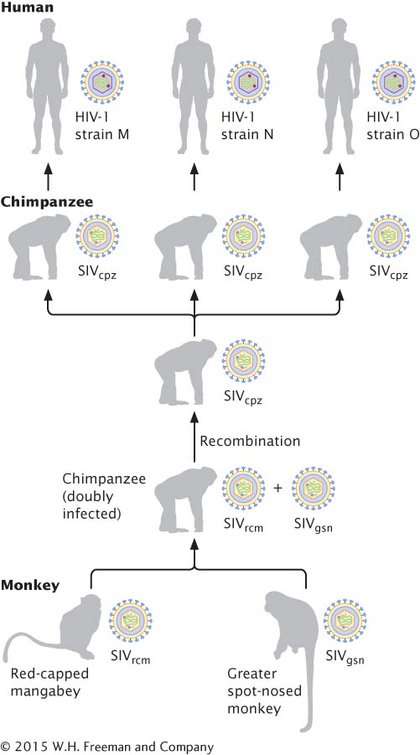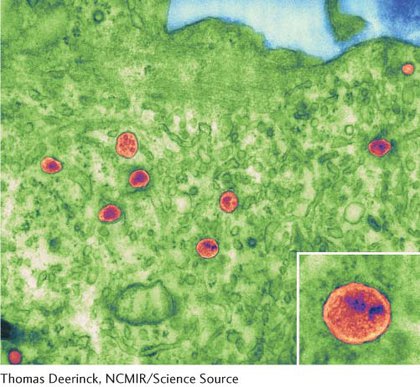Human Immunodeficiency Virus and AIDS
An example of a retrovirus is human immunodeficiency virus (HIV), which causes acquired immune deficiency syndrome (AIDS). AIDS was first recognized in 1982, when a number of homosexual males in the United States began to exhibit symptoms of a new immune system–deficiency disease. In that year, Robert Gallo proposed that AIDS was caused by a retrovirus. Between 1983 and 1984, as the AIDS epidemic became widespread, the HIV retrovirus was isolated from people with the disease. AIDS is now known to be caused by two different immunodeficiency viruses, HIV-
HIV illustrates the importance of genetic recombination in viral evolution. Studies of the DNA sequences of HIV and other retroviruses reveal that HIV-

HIV is transmitted by sexual contact between humans and through any type of blood-
HIV principally attacks a class of blood cells called helper T lymphocytes, or simply helper T cells (Figure 7.28). HIV enters a helper T cell, undergoes reverse transcription, and integrates into the chromosome. The virus reproduces rapidly, destroying the T cell as new virus particles escape from the cell. Because helper T cells are central to immune function, people with AIDS have a diminished immune response; most people with the disease die of secondary infections that develop because they have lost the ability to fight off pathogens.

The HIV genome is 9749 nucleotides long and carries gag, pol, env, and six other genes that regulate the life cycle of the virus. HIV’s reverse transcriptase is very error prone, giving the virus a high mutation rate and allowing it to evolve rapidly, even within a single host. This rapid evolution makes the development of an effective vaccine against HIV particularly difficult. Genetic variation within the human population also affects the virus. To date, more than 10 loci in humans that affect HIV infection and the progression of AIDS have been identified.
CONCEPTS
A retrovirus is an RNA virus that integrates into its host’s chromosome by making a DNA copy of its RNA genome by reverse transcription. Human immunodeficiency virus, the causative agent of AIDS, is a retrovirus. It evolved from related retroviruses found in other primates.
 CONCEPT CHECK 7
CONCEPT CHECK 7
What enzyme is used by a retrovirus to make a DNA copy of its genome?
Reverse transcriptase